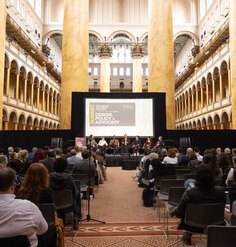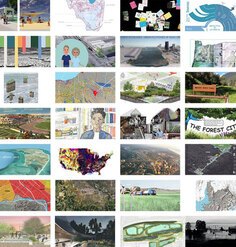Has Landscape Architecture Failed? Reflections on the Occasion of LAF’s 50th Anniversary
By Richard Weller and Billy Fleming, University of Pennsylvania
In 1966, Campbell Miller, Grady Clay, Ian McHarg, Charles Hammond, George Patton, and John Simonds marched to the steps of Independence Hall in Philadelphia and declared that an age of environmental crisis was upon us and that the profession of landscape architecture was a key to solving it. Their Declaration of Concern launched, and to this day underpins the workings of, the Landscape Architecture Foundation (LAF).
To mark its 50th anniversary, LAF will hold a summit titled The New Landscape Declaration at the University of Pennsylvania involving over 65 leading landscape architects from around the world. Delegates are being asked to deliver new declarations (manifestos, if you will) about the profession’s future. Drawing upon these statements and the dialogue at the summit, LAF will then redraft the original 1966 Declaration of Concern so that it serves to guide the profession into the 21st century.
On one level, redrafting the declaration is relatively straightforward: it would simply need to stress the twinned global phenomena of climate change and global urbanization — issues that were less well understood in 1966. On another level, however, the redrafting of the declaration is profoundly complicated because if it is to be taken seriously, then a prerequisite is to ask why, after 50 years of asserting landscape architecture as “a key” to “solving the environmental crisis” does that crisis continue largely unabated? Seen in this light the declaration can be read as an admission of failure. Consequently, we must ask:
If McHarg and his colleagues were justified in placing such a tremendous responsibility on the shoulders of landscape architects, why have we failed so spectacularly to live up to their challenge?
In our defense, we might argue that landscape architecture is a very young and very small profession and an even smaller academy. We can also protest, as many do, that other more established disciplines — such as engineering and architecture — have restrained our rise to environmental leadership. We can argue that the status quo of political decision-making makes it impossible for us to meaningfully scale up our operations and work in the territory where our services are needed most. These justifications (or excuses) all contain aspects of the truth, but we argue that landscape architecture over the last 50 years is less a story of abject failure and more one of a discipline taking the time that has been needed to prepare for a more significant role in this, the 21st century.
From the last 50 years of landscape architecture, we have three models of professional identity and scope: the landscape architect as artist (for example, Peter Walker), the landscape architect as regional planner (for example, Ian McHarg), and the landscape architect as urban designer (for example, Charles Waldheim). Rather than see these as competing models canceling each other out, perhaps what we have really learned from the last 50 years is that each is somewhat incomplete without the other. If however, we make a concerted effort to combine these three models, then perhaps we begin to really give credence to the notion of landscape architecture as a uniquely holistic discipline, one especially well-suited to engage with the contemporary landscape of planetary urbanization and climate change.
Considering our historical moment, one is reminded of the incredible optimism with which the moderns announced theirs. In 1920 the great architect Le Corbusier launched his journal L’Esprit Nouveau with the declaration: “There is a new spirit: it is a spirit of construction and synthesis guided by a clear conception … A great epoch has begun.” A mere 46 years later a small group of landscape architects would declare that epoch as one of environmental crisis. And now, precisely 50 years later as we acknowledge their original Declaration of Concern, the International Commission on Stratigraphy is expected to formally announce the dawn of the Anthropocene Epoch: a new geological period defined by the fact that the earth’s systems are now fundamentally and irreversibly altered by human activity.
The philosophical and practical consequences couldn’t be greater: in short, Nature is no longer that ever-providing thing ‘out there’; it is, for better or worse, the world we have created and the world we are creating. The landscape of the Anthropocene is one of permanent ecological crisis. As such, the Anthropocene is overwhelming, but since it is by definition a human creation, the Anthropocene is something we must take responsibility for, something we can design. This doesn’t automatically mean the hyper-modernity of geoengineering planetary systems, but it does return us, humbly and critically to McHarg’s concept of stewardship.
This is now landscape architecture’s century — all the major issues of the times are at root about how we relate to land — and if by the end of it we are still small, weak and ineffectual, and if the world is a worse place than it is now, then we will only have ourselves to blame.
Richard Weller is the Martin and Margy Meyerson Chair of Urbanism and Professor and Chair of Landscape Architecture at the University of Pennsylvania. He serves on the Landscape Architecture Foundation’s Board of Directors. Billy Fleming is a Doctoral Fellow in City and Regional Planning at the University of Pennsylvania.










